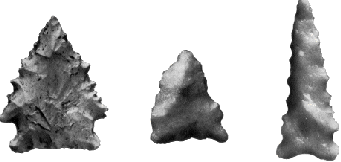
to hold Archaic points onto spears, sinew and plant fibers were strapped around notches at the bottom
Source: National Park Service Southeast Archeological Center, Outline of Prehistory and History

to hold Archaic points onto spears, sinew and plant fibers were strapped around notches at the bottom
Source: National Park Service Southeast Archeological Center, Outline of Prehistory and History
The transition from the Paleo-Indian to the Archaic Period 10,000 years ago (or 8,000BCE) is defined largely by a shift in the design of points. As the climate warmed and hardwood forests replaced the steppe and boreal forests, ecological niches were transformed. Elk, buffalo, deer, and smaller mammals replaced the mastodons and mammoths. The bands of hunters and gatherers developed new techniques to hunt smaller game, using new weapons.
The climate changed, transforming habitats and where hunting/gathering would be productive. Virginia had no glaciers in the last Ice Age; the southernmost edge of the last ice sheet was in Pennsylvania and New York. However, cold and dry winds blowing south off from the ice sheet shaped the vegetation. Altered vegetation patterns altered the population mix of animals, and those changes created different hunting opportunities in Virginia.
Until 12,000BCE, the Valley and Ridge physiographic province may have been included a mix of grasslands (kept open by bison, mammoths, mastodons, and other megafauna) plus large boreal forests with a high percentage of pine, spruce and fir trees. Deciduous trees were thrived best in sheltered stream valleys.
As glaciers retreated and the climate warmed and got wetter, deciduous forests extended up the mountains. Evidence for the ecological change includes increasing amounts of alder pollen appearing in the sediment cores from Browns Pond, a sinkhole in Bath County. The warmer, drier climate between 8,000-6,000BCE spurred the expansion of oaks, hickories, maples and beeches.1
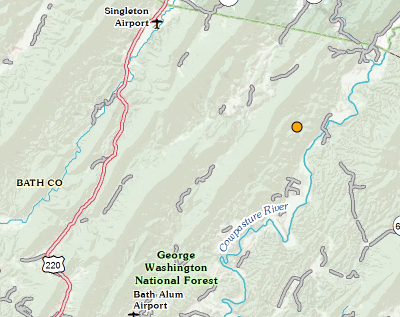
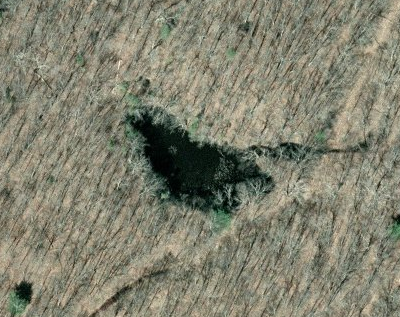
Browns Pond, a sinkhole in Bath County with pollen dating back 17,000 years, is currently surrounded by deciduous forest
Source: U S Geological Survey, The National Map
In the Paleo-Indian Period, bands of hunters had strapped large points onto long spears and killed mastodons, mammoths, and other large megafauna. Such hunts could have been a common event that could provide a major meal, or rare rituals to demonstrate "coming of age" and continued skill of adult hunters seeking prestige. Then climate change and over-hunting by the Paleo-Indians exterminated the large mammals.
The exact cause of extirpation of the megafauna remains disputed, but species which had survived previous climate fluctuations disappeared. The new predators, hunting with spears tipped with Clovis and other points, may have eliminated too many of the young mammoths and mastodons. Young animals were smaller, but easier to kill. Megafauna species with a low reproductive rate may have been vulnerable in previous climate fluctuations, but the removal of young by human hunting could have tipped the balance.
The Archaic Period is marked by the adoption of smaller points, without the flakes chipped away in the center ("flutes") of Clovis points. When hunting smaller game, smaller points attacked to shorter spears were more effective. Chipping out flutes to make it easier to attach sharpened stones to large straight spears lost its value, when smaller game required smaller spears:2
Smaller points could also be placed on short spears and projected with atl-atls. Adoption of the atl-atl technology, which enable tossing small spears at faster speeds, is one way to distinguish the Paleo-Indian vs. Archaic periods. Archeologists in Texas have unearthed a hunting kit over 6,000 years old with an atl-atl, boomerang, and spear tips that may have been dipped in poison.3
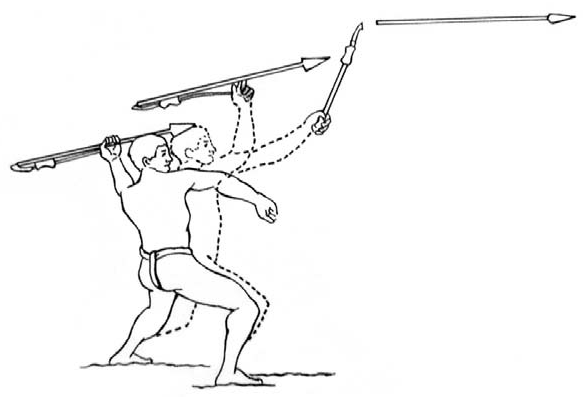
the atl-atl enabled people in the Archaic Period to throw stone-tipped projectiles further than spears
Source: Virginia Historical Society, Becoming a Homeplace
Source: Fairfax Public Schools, Mysterious Artifacts and the Atlatl
In the Archaic Period, the increase of deciduous trees in Virginia's forests produced more fruits and nuts, especially on the Coastal Plain that was being slowly flooded by the rising Atlantic Ocean. New foods appeared as the Ice Age ended, though old food sources such as the megafauna disappeared.
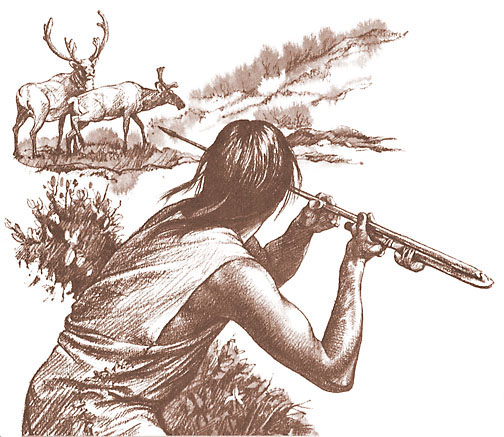
in the Archaic Period, after the demise of megafauna such as mammoths, the atl-atl was an effective tool for hunting caribou, elk and deer
Source: Georgia Studies Images, Archaic Indian Hunting with Atlatl
People hunted a wider variety of animals as smaller forest and grassland game became more common. In the Archaic Period, bands of hunters and gatherers scattered more widely across the landscape and spent less time concentrated in the river bottoms. More food was available, and perhaps on a more-reliable basis year-round. The Homo sapiens species took advantage of the changes, and the total population of humans increased gradually.
For the human living in Virginia during the Archaic Period, the concept of "environmental determinism" suggests that living patterns changed because the ecosystems changed. Cultural change could also have been a factor. The rapid spread of the Clovis point style suggests close social interactions among people connected by trading networks. In the Archaic Period, trading patterns could have been disrupted and lifestyles modified as different groups adopted different spiritual perspectives. Speculation of cultural changes are far harder to evaluate, in contrast to the preserved evidence of environmental change.
During the Early Archair Period 10,000-8,500 BP (Before Present):4
Bands of hunters and gatherers, typically including one-five separate families, were able to find adequate food resources. The number of people in an area stayed below the ecological carrying capacity and access to food was not a limiting factor, assuming that social factors caused bands to fission into separate groups when they exceeded 25-30 people in size. Perhaps 15 hours/week were devoted to gathering fruits, nuts, seeds, and insects; life was not "nasty, brutal and short." Hunting large animals may have been done primarily by males who had greater strength, and a steady supply of meat was not required for survival.
Based on where Archaic Period campsites have been found, family units took fewer long journeys and roamed in more places. Population growth may have led to more defined territories that were defended by different groups. Less-mobile groups utilized a wider range of local stone to make their tools. The hunters were no longer "tethered" by culture to using a few specific quarry sites that supplied the raw material for restocking the toolkit, or perhaps most groups were excluded from traditional quarries as local residents created "turf boundaries" which blocked access by strangers.
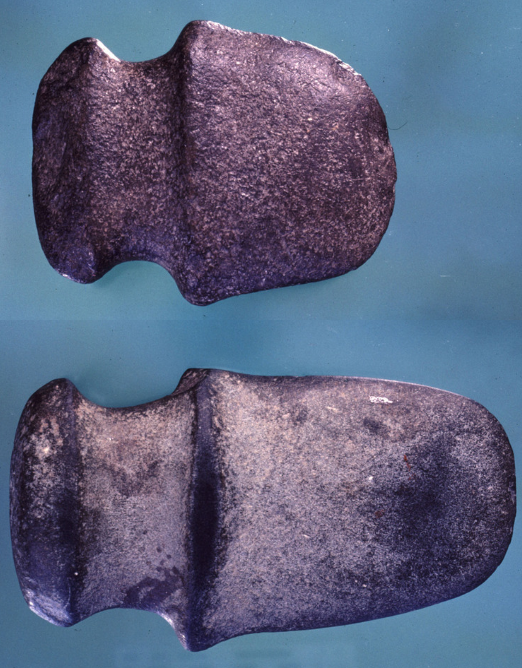
in the Archaic period, stones were pecked and ground to create axes for working with wood
Source: Virginia Humanities, Virginia Indian Archive, Grooved Stone Axes
People appear to have ranged on a cycle through a particular set of river valleys that provided water, fruit, nuts, fish, game, plus stone for weapons and plant fibers for making baskets, clothing and shelters. The "seasonal round" required less travel as reliable sources of food were identified.
In stream valleys visited on a regular basis, some seeds stripped from plants for food were spread accidentally across more soil, expanding the population of preferred species. In the watershed of the Mississippi River, some groups began intentionally assisting plants to grow. Species were gradually domesticated so seeds ripened at he same time and stayed on the plant, making it possible to harvest larger quantities of food in fewer visits.
The need to move long distances was reduced as food sources nearby became more abundant and reliable. In the Late Archaic Period 4,500-3,200 BP, people began to live in larger semi-sedentary camps to exploit a more localized territory with greater intensity. In separate watersheds, people developed into a:5
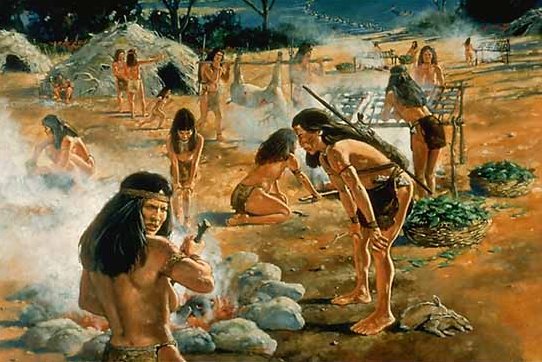
a Late Archaic settlement may have included soapstone slabs used in cooking and fish being smoked over a fire
Source: National Park Service Southeast Archeological Center, Beneath These Waters
"Residentially stable" does not mean construction of permanent houses. Archaic sites lack post molds, so humans may have used temporary structures for shelter without excavating holes for installing any framework of branches. Some places could have been visited so regularly that the occupants made permanent improvements, even though the site was occupied just seasonally. The oldest house site in North America, a pre-Clovis component at the Gault Site in Texas, had a stone floor.6
Foraging groups were constantly on the move. They would exploit plants in a valley and harvest game on a ridgeline before moving to another location to acquire food.
Archaic Indians used less-specialized rock for their tools, perhaps because the new areas occupied by hunting bands were further from known quarries such as Flint Run (Warren County). The shaping of points and blades in the toolkit - especially the way the base of points were notched - shifted as well. The different way of attaching points to spears reflects new techniques for hunting with smaller tools. Hunters using the atl-atl needed a small stone/bone dart tip.

the "atl-atl" that enhanced Archaic technology for throwing a spear
Source: National Park Service

how to throw an atl-atl
Source: National Park Service
Archaic Virginians knew where to hunt and when to harvest food from plants, because they knew their territory. In brackish and saltwater areas, people would have relied heavily upon oysters, turtles, and crabs. Shell ring sites in the southeastern United States along the coasts of South Carolina, Georgia, Florida, and Mississippi are Archaic Period architectural features. The circular and semi-circular piles of oyster shells (primarily) range in size from 188-800 feet in diameter and 3-20 feet in height. Shell rings were formed 3,000-5,000 years ago.7
During the Archaic Period, people would have and feasted on the occasional beached whale as well. Beaches where whale meat was roasted are now under the waves of the Atlantic Ocean, since sea level has risen since the time of Archaic settlement.
Not surprisingly, it appears that these more-settled groups may have defended their territory and excluded competitors. Protein sources had value, and places that provided a reliable supply of seafood were worth defending. That behavior led to some social isolation, and different regions developed different styles of notching their points to hunt the type of game that was most common in their local area.
Settling down, utilizing different types of rocks to make tools, developing smaller points, and inventing the atl-atl distinguish the Archaic period culture from the Paleo-Indian period culture. Some groups also quarried steatite, a soft soapstone created when deep ocean basalt was metamorphosed during the formation of Pangea, to make stone bowls.
Previously, food had been eaten raw or cooked in containers manufactured from animal skins, bark, and plant fibers. Chunks of meat could be speared on a stick and roasted directly over a fire, but that was not feasible for seeds, roots, and other small food items. Those were converted into stews and soups.
Water, seeds, rots, and various parts of animal were placed into a container. Small stones were heated, then transferred from the fire and dropped carefully into the pot for indirect heating of the meal.
Unlike organic containers, steatite bowls could be placed in the embers of a fire for direct heating. Groups that carved stone bowls could extract more energy from food they gathered and hunted, including small scraps, but the heavy bowls made the groups less mobile.
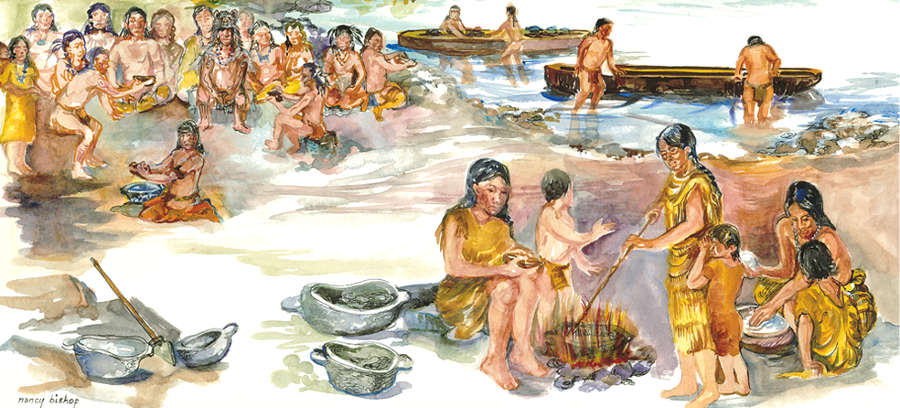
steatite (soapstone) bowls allowed direct heating in a fire to cook soups and stews
Source: Pennsylvania Historical and Museum Commission, Transitional Period
Rock outcrops in Fairfax County still show evidence of the extraction of the soft soapstone.
The seasonal round in stream valleys led slowly to the invention of agriculture. That significant change is used as a marker of the change in culture from the Archaic Period to the Woodland Period. Other changes included widespread construction of burial mounds and the development of pottery.
During what we define today as the Archaic Period, Virginians used the atl-atl to hunt game and lived in defined locations for significant parts of the year. The original First Families of Virginia did not have a key technology that would be developed later - the bow and arrow.
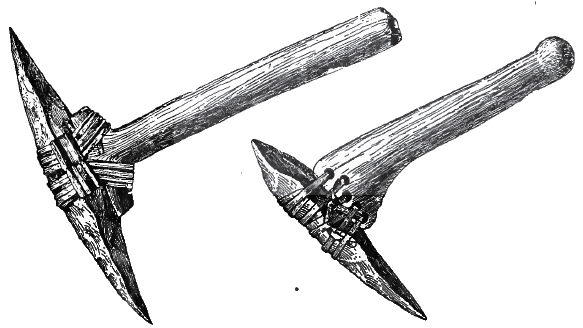
soapstone quarried at Clifton in Fairfax County was hafted to wooden handles to create picks/chisels
Source: Stone implements of the Potomac-Chesapeake tidewater province (1887, Figure 17)
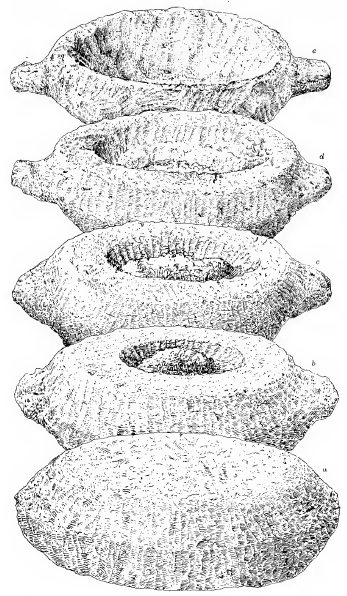
soapstone quarried at Clifton was carved by stages into bowls
Source: Stone implements of the Potomac-Chesapeake tidewater province (p.123)